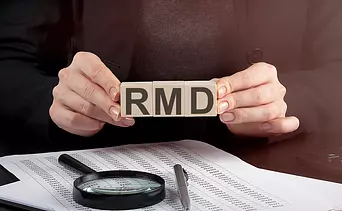Global View Investment Blog
Over 72, Don't Forget Your RMDs (Required Minimum Distributions)
By the time we reach age 72, the essential things in life seem much clearer: Enjoying our retirement (assuming we decide to retire), protecting our wealth, and helping our families. This is also the age at which we must begin receiving distributions from our qualified retirement plans and IRAs.
If you've accumulated a large nest egg, those distributions and the taxes on them will be sizable. But, rules changes in 2019 have altered the complexion of RMDs and provided retirees with new possibilities. Let's take a closer look.
This blog answers the following:
- Why are RMDs required?
- What are the requirements for distribution?
- What are the RMD penalties?
- How Can a Financial Advisor in Greenville, SC, help?
Why Are RMDs Required?
The answer boils down to one word: Taxes. RMDs ensure you pay taxes on your retirement savings. Uncle Sam gives workers an excellent tax break by allowing folks to contribute to IRAs and qualified retirement plans (such as 401(k)s, 403Bs, and 457Bs). For traditional; non-Roth plans, those contributions are pre-tax, reducing your current taxes and growing tax-deferred until you distribute the money.
The IRS and local governments have been very patiently waiting to tax all that money in our retirement accounts. Their patience runs out at age 72 (with one exception that we explain below). It's nice to reap the rewards of a lifetime of saving and investing, but the taxes on them can create headaches for high-net-wealth individuals, possibly pushing you into higher tax brackets.
If You’re Nearing Retirement & Wondering How To Navigate All of These Matters, Read This.
What Are the Requirements for Distribution?
Generally, you must begin taking your RMDs at age 72. The single exception allows people still working at that age to delay the distributions from their current employer-sponsored plans until they retire.
RMDs pertain to the following retirement plans:
- Traditional IRAs, SEPs, and SARSEPs
- SIMPLE IRAs and Roth 401(k) accounts
- 401(k), 403B, and 457B accounts
When Are Distributions Due?
You must take your first RMD by April 1st of the year in which they initially apply. For example, if you reach age 72 in 2023, you must take your first IRA RMD by April 1, 2024. Subsequent ones are due by December 31 each year, beginning in the same year as the initial RMD (in this example, December 31, 2024).
The same dates apply to 401(k), 403B, and 457B accounts—unless you are still working, in which case you must take your initial RMD in the calendar year following your retirement. The RMD work waiver does not apply if you own 5% or more of your employer.
How Much Must Be Withdrawn?
The RMD amount for the current year depends on the account's value on December 31 of the previous year. For example, an RMD in 2024 is based on the account value as of December 31, 2023.
To calculate the RMD amount, you must look up an age-based number, your life expectancy factor (LEF), which you'll find in the IRS Uniform Lifetime Table for the tax year. The RMD amount for the year is equal to the account's value as of the end of the previous year divided by the LEF.
For example, suppose your IRA has a $1 million balance on December 31, 2023, when you are 72: The IRS Uniform Lifetime Table places your LEF at 27.4. Your RMD equals $1 million / 27.4, or $36,496.35. Naturally, your LEF decreases as you age, which would require a larger distribution if you had an identical balance.
For instance, let’s say you still had $1 million in your IRA at age 80, when your LEF is 20.2. In this case, your RMD would be $49,504.95. Of course, you would expect your IRA balance to decrease after you retire, so the actual amount of the required distribution will also decline.
Please note: If your spouse is the only beneficiary of your retirement account and is 10 or more years younger than you, you must use the LEF from the IRS Joint Life Expectancy Table. Roth IRAs do not have RMDs unless they are inherited. However, any Roth accounts in your qualified retirement plans are subject to RMDs.
Can I Continue to Contribute After Age 72?
Yes, you can, and it's deductible. Think of post-RMD contributions as a way to partially replenish your retirement savings and reduce the taxes on your current work earnings. You cannot reinvest your RMDs into your retirement accounts.
Remember, also, that your contribution amount is limited to the lesser of:
- Your taxable, work-related earnings (excluding your RMDs and investment income),
or
- The statutory contribution cap on the account type.
So, if you—and your spouse, if you file jointly—don't collect taxable, non-RMD earnings in the year, you can't contribute to your retirement account. For folks age 50 and older, the 2023 statutory caps on contributions (including catch-up contributions) are:
IRAs: $7,500
401(k)s, 403Bs, 457Bs, SARSEPs: $30,000
SIMPLE IRAs: $19,000
Self-employed SEPs: The lesser between 25% of your net earnings and $66,000
If a qualified employer retirement plan covers you or your spouse, the deductibility of your IRA contributions is income-limited. For example, if you file a joint return and have both types of plans in 2023, your IRA deductions are limited when your modified adjusted gross income (MAGI) is greater than $116,000 and not allowed if $136,000 or more.
If a workplace plan covers only your spouse, your IRA 2023 deductible income limits are $218,000 and $228,000, respectively.
What Are the RMD Penalties?
If you fail to take your total RMD for the year, you'll face a 50% penalty (plus income tax) on the shortfall. The IRS may forego the penalty if it is due to an honest mistake and you file Form 5329 with a letter requesting relief.
You can withdraw more than your RMD amount each year, but never less. The amount that you withdraw in excess of your RMD doesn't count toward later RMDs.
How Can a Financial Advisor in Greenville, SC, Help?

Our team of financial advisors in Columbia, SC, and Greenville, SC, can help you plan and calculate your RMDs. We also can work with you to reduce the net tax impact of RMDs, using strategies that include charitable donations, Roth IRA conversions, tax-efficient investing options, and retirement plan contributions.
Contact us for an appointment to discuss your retirement plans and wealth preservation. We look forward to hearing from you.

Written by Matthew Crider
Matt is a CERTIFIED FINANCIAL PLANNER™ professional who has been in the financial advisory business since 2008. He holds a BA in Marketing and Management from the University of Cincinnati and his MBA from Clemson University. Prior to Global View, Matt began his career with Fidelity Investments. His specialties at Global View include asset accumulation and investment strategies; college funding strategies; budgeting discipline and analysis; multi-generational planning; and life event changes, such as marriage, kids, home purchase, retirement, etc.
Are you on track for the future you want?
Schedule a free, no-strings-attached portfolio review today.
Talk With Us






